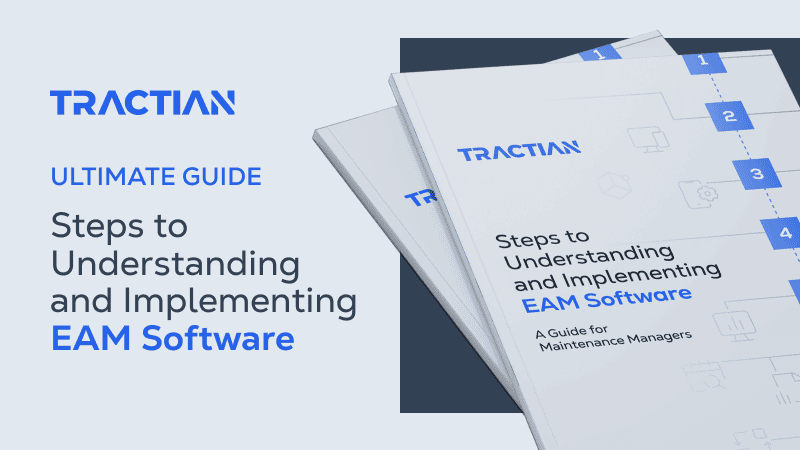Mean time to resolve is the metric that tells you how long your operations are actually affected when problems occur. It includes everything from the moment an issue is detected until it's completely fixed and confirmed.
Tracking MTTR gives you a comprehensive view of incident response, helps you identify bottlenecks, improves repair processes, and ultimately keeps your equipment running more reliably.
In this guide, we'll examine what MTTR really entails, how to calculate it accurately, and most importantly, how to use it to drive meaningful improvements in your maintenance operations.
What Is Mean Time To Resolve (MTTR)?
MTTR stands for Mean Time To Resolve. However, caution is warranted because this acronym (MTTR) can have different meanings depending on the context. In maintenance and incident management, you may encounter four main variations: Mean Time to Repair, Mean Time to Recovery, Mean Time to Respond, and Mean Time to Resolve.
These aren’t four different ways of talking about the same thing. And, while the confusion is unfortunate, the distinction matters because each metric measures a different aspect of your incident response. For instance, if you're tracking repair efficiency, you want Mean Time To Repair. If you're measuring business continuity, Mean Time To Recovery makes more sense.
For those concerned with comprehensive incident management, Mean Time to Resolve provides the whole picture. It extends from the moment an issue is detected until it's completely resolved and verified in your system. And, it’s the metric that tells you how long your customers or operations are actually affected.
Here’s a quick breakdown of where each is most effective:
- Mean Time To Resolve: Complete incident lifecycle from detection to closure
- Mean Time To Repair: Actual hands-on fix time
- Mean Time To Respond: Time until first action is taken
- Mean Time To Recovery: Time until service is restored
Defining Mean Time To Resolve vs Other Metrics
Understanding what MTTR stands for becomes clearer when you compare Mean Time To Resolve with other incident management metrics. Each metric serves a distinct purpose in evaluating your team's performance and identifying areas for improvement. You could also say that mean time to repair, respond, and recover are aspects of the full resolution, or mean time to resolve.
Overall, these metrics work together to provide a complete picture of your maintenance management effectiveness. You might have excellent repair times but poor response times, or fast acknowledgment but slow resolution. Each metric reveals different strengths and weaknesses in your process.
Now, we’ll continue to examine Mean Time to Resolve.
How To Calculate the MTTR Formula
The MTTR formula is straightforward: Total Resolution Time ÷ Number of Incidents = MTTR. Obtaining accurate and meaningful results requires careful attention to what you're measuring and how you're measuring it.
For example, imagine your team tracked all incident resolutions over the course of a month, recording the total time spent addressing each one. In this example, dividing the total resolution time by the number of incidents yields the average MTTR per incident. It’s simple math, but the devil is in the details of what counts as "resolution time" and how you define an "incident."
Here’s how you can calculate MTTR in four steps.
1. Identify Total Resolution Duration
When you calculate MTTR, resolution time begins when an incident is first detected and ends when it's completely resolved and verified. This includes diagnosis time, repair time, testing time, and any delays between these phases.
You need to decide whether to use business hours or calendar time. Business hours make sense if your team only works during specific hours, but calendar time gives you a more realistic picture of customer impact.
Regardless, the key is consistency. Whatever method you choose, apply it to all incidents to ensure meaningful comparisons.
2. Count Number Of Incidents
Define what constitutes an "incident" for your MTTR calculation. Is a recurring issue that requires multiple interventions counted as one incident or several? Do you count minor issues the same as major outages?
Most teams benefit from categorizing incidents by severity. A critical system failure that affects production deserves different treatment than a minor software glitch that affects one user.
Track all incidents consistently, including the quick fixes. Those 10-minute resolutions balance out the complex problems that take days to solve.
3. Divide Duration By Incident Count
Here's where the rubber meets the road. If your team spent 100 hours resolving 20 incidents in a month, your MTTR is 5 hours per incident. But that average might hide important patterns.
In some cases, less complex incidents can be resolved much more quickly than complex ones, illustrating how averages can hide important differences in resolution times. While the calculated average may appear straightforward, examining the distribution of resolution times can reveal important insights about your team's strengths and the variety of challenges they encounter.
Consider tracking MTTR by incident category or severity level to get more actionable insights.
4. Note Real World Variables
Several factors can affect your MTTR calculation and should be considered when interpreting results. Business hours versus 24/7 calendar time can dramatically change your numbers, especially if incidents occur outside normal working hours.
Incident severity classifications matter because a 30-minute network outage and a 3-day equipment failure shouldn't be weighted equally. Seasonal variations might affect both incident frequency and resolution time. Holiday schedules, weather-related issues, or production cycles all play a role.
Team size and resource availability have a direct impact on resolution time. A fully staffed team during peak hours will likely resolve incidents faster than a skeleton crew on weekends.

Common Challenges With MTTR Metrics
Even with a solid understanding of the calculation, teams often struggle with practical implementation issues that can undermine the value of their MTTR tracking. These challenges aren't just technical but organizational and procedural.
Inconsistent measurement tops the list of problems. Different team members may start the clock at different points or use different criteria to determine what constitutes "resolved." One technician might consider an issue resolved when the immediate problem is fixed, while another waits for full system verification.
Outlier incidents can skew your averages in misleading ways. A single complex incident that takes 40 hours to resolve can make your monthly MTTR look terrible, even if you handled 50 other incidents quickly and efficiently.
Unclear resolution points create confusion about when to stop the clock. Is an incident resolved when the system is working again, when the customer confirms satisfaction, or when you've implemented preventive measures to avoid recurrence?
Tool limitations often force teams to resort to manual tracking or incomplete data collection. If your incident management system doesn't capture all the data you need, or if it's too cumbersome to use consistently, your MTTR calculations will be based on incomplete information.
The solution to these challenges isn't perfect tools or processes, but clear standards and consistent application. Document your measurement criteria, train your team on proper tracking procedures, use an FMEA spreadsheet, and regularly audit your data quality to ensure your MTTR metrics accurately reflect reality.
4 Practical Steps To Reduce Time To Resolve
Improving MTTR requires a systematic approach that addresses every phase of incident management, from initial detection through final resolution. The goal isn't just faster response times, but more efficient and effective incident handling that reduces both immediate impact and long-term risk.
1. Improve Detection Methods
Faster detection directly reduces your MTTR by shortening the time between when a problem occurs and when your team starts working on it. Many incidents go undetected for hours or even days, inflating resolution times before work even begins.
Implementing robust predictive monitoring means setting up automated alerts for critical system parameters, not just obvious failures. Temperature sensors, vibration monitors, performance metrics, and condition monitoring can detect problems before they lead to complete breakdowns.
Setting appropriate alert thresholds requires striking a balance between sensitivity and noise. Too many false alarms, and your team will start ignoring alerts. Too few alerts, and you'll miss early warning signs of developing problems.
2. Streamline Communication
Communication delays often account for a significant portion of total resolution time, especially in complex incidents that require coordination between multiple teams or departments. Clear, efficient communication protocols can dramatically reduce these delays.
Implementing standardized incident communication channels means everyone knows where to report problems and where to find updates. Whether it's a dedicated Slack channel, email distribution list, or incident management platform, consistency eliminates confusion.
Creating clear escalation paths ensures that incidents get the right level of attention without unnecessary delays. Junior technicians should know exactly when and how to escalate to senior staff, and managers should know when to bring in external resources.
3. Automate Repetitive Tasks
Automation reduces the manual intervention required for routine aspects of incident response, freeing up your team to focus on diagnosis and resolution rather than administrative tasks. This directly impacts MTTR by eliminating delays and reducing human error.
Automating incident detection and alerting ensures that problems are flagged immediately when they occur, without requiring someone to manually create a ticket. This can save hours on incidents that might otherwise go undetected.
Using runbooks for common issues provides step-by-step guidance for resolving frequent problems, reducing the time technicians spend figuring out what to do next. Well-designed runbooks can turn a 2-hour troubleshooting session into a 30-minute procedure.
4. Train Teams And Document Processes
The human element remains crucial in incident resolution, even with the best tools and automation. Well-trained teams with access to comprehensive documentation can resolve incidents more quickly and effectively than those working from memory or improvising solutions.
Creating comprehensive documentation means more than just technical manuals. It includes troubleshooting guides, contact lists, escalation procedures, and lessons learned from previous incidents. This documentation should be easily accessible during high-stress situations.
Building knowledge bases of common issues and solutions creates a searchable repository of troubleshooting information that can dramatically reduce diagnosis time for recurring problems.
Limitations And Pitfalls Of Mean Time To Recovery
While MTTR provides valuable insights into incident management performance, over-focusing on this single metric can create unintended consequences that actually harm your overall incident response effectiveness. Understanding these limitations helps you use MTTR appropriately as part of a broader performance measurement strategy.
Rushing resolutions to improve MTTR numbers can lead to incomplete fixes that create recurring problems. A technician who applies a quick corrective maintenance fix to get systems running again might achieve a great MTTR score, but if the underlying issue isn't addressed, the same problem will resurface within days or weeks.
Teams might prioritize speed over thoroughness when they're being measured primarily on resolution time. This can result in missed root causes, inadequate testing of fixes, or insufficient documentation of the actions taken and their rationale.
Some incidents legitimately take longer to resolve, regardless of how efficient your processes are. Complex system failures, vendor-dependent issues, or problems requiring specialized expertise can't be rushed without compromising quality or safety.
- Incidents are being closed prematurely to improve numbers
- Teams are avoiding thorough root cause analysis
- The same incidents keep recurring
- Quality of fixes is declining
- Team morale is suffering due to pressure
Why MTTR Matters For Incident Management Metrics
MTTR serves as a critical indicator of operational resilience, directly impacting both immediate costs and long-term business performance. When incidents are resolved quickly and effectively, the ripple effects extend far beyond the immediate technical fix.
The direct correlation with downtime costs is perhaps the most obvious business impact. Every minute of system unavailability translates to lost productivity, missed opportunities, and potential revenue loss. In manufacturing environments, unplanned downtime can have significant operational and financial consequences.
Customer satisfaction and retention suffer when incidents drag on without resolution. Users experiencing system problems want to know that someone is actively working on the issue and that it will be fixed promptly. Eventually, long resolution times will erode confidence in your systems and services.
Team morale and burnout are often overlooked consequences of poor MTTR performance. When incidents consistently take longer than necessary to resolve, technicians become frustrated, stressed, and less effective.
Johnson Controls gained $2.6M in savings after implementing Tractian solutions. "With the adoption of TRACTIAN solutions, the maintenance team at Johnson Controls can now detect and diagnose failures early on with increased accuracy." They maintain an average MTTR of 12.4 hours, preventing costly downtime.
How MTTR And MTBF Work Together
MTTR and MTBF (Mean Time Between Failures) are complementary metrics that together provide a complete picture of system availability and reliability. While MTTR measures how quickly you recover from problems, MTBF measures how often problems occur in the first place.
MTTR measures resolution efficiency, showing how well your team responds to and fixes problems when they occur. A low MTTR indicates that your incident response processes are working effectively and your team has the skills and resources needed to resolve issues quickly.
MTBF measures system reliability, indicating how long your equipment typically runs without experiencing failures. A high MTBF indicates that your preventive maintenance programs are effective and your systems are inherently reliable.
Together, these metrics determine overall system availability using the formula: Availability = MTBF ÷ (MTBF + MTTR). This formula demonstrates that you can enhance availability by either increasing MTBF (reducing the frequency of failures) or decreasing MTTR (improving the speed of failure resolution). Implementing reliability-centered maintenance addresses both sides of that equation.
How Tractian's CMMS Can Elevate Your Operation
Reducing MTTR isn't just about working faster, but working smarter, with systems that support efficient incident response and resolution. The right CMMS transforms how your team detects, diagnoses, and resolves problems by providing real-time visibility and structured workflows that eliminate delays and confusion.
Most maintenance teams struggle with MTTR because their tools don't support the speed and accuracy needed for effective incident management. Scattered information, manual processes, and disconnected systems create friction that unnecessarily extends resolution times.
With features like automated alerting, mobile access, and integrated asset monitoring, Tractian's CMMS enables teams to identify problems earlier and respond more effectively. Real-time dashboards provide visibility into incident status and team performance, while comprehensive reporting helps detect patterns and opportunities for improvement.
The platform's intuitive design allows your team to focus on solving problems rather than struggling with software. Everything they need (procedures, parts information, contact details, and historical data) is available instantly, reducing the time spent gathering information and increasing the time spent on actual resolution work.
Ready to see how our software can help you achieve faster, more effective incident resolution?



